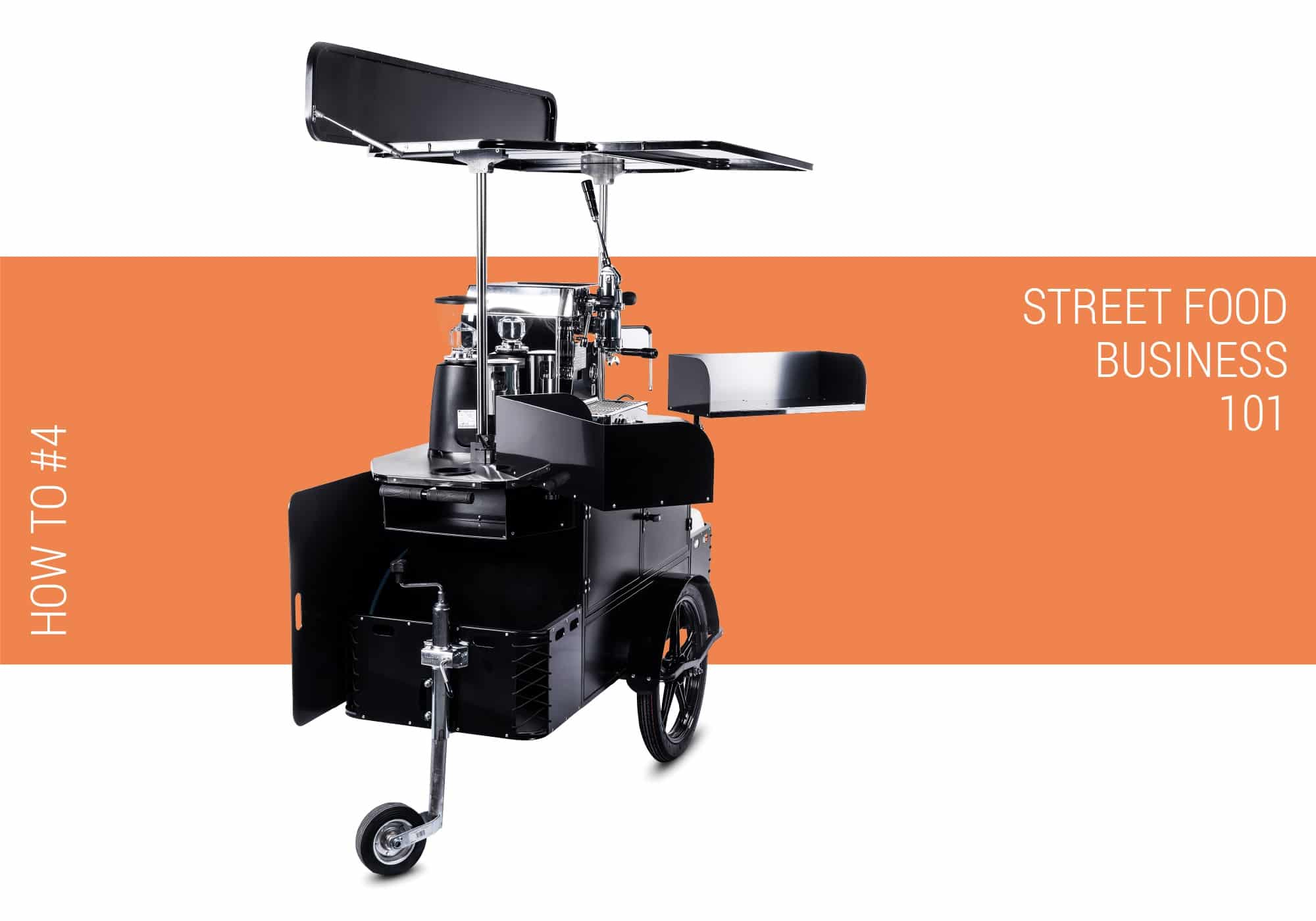How to Start a Coffee Cart Business
So you’ve been thinking about starting a coffee cart business but you’re not sure where to begin? We know firsthand that setting it up can be challenging, yet there are huge profits available to those who get things right. Hence the aim of this article: to provide you with some useful insight into what it’s going to take to successfully launch your mobile coffee shop business.
We’ve laid down the general recommendations that you should consider before you begin. However, since each coffee cart business and its particularities will differ from the next, these recommendations and their implementation will also vary from case to case. So we trust that you’ll be able to use what’s relevant to you and leave out what doesn’t apply, focusing on developing your particular coffee cart business plan
But first, let’s dig a little deeper into the opportunities, advantages, and the challenges of this kind of venture.
The Opportunities, Advantages, and Challenges of a Coffee Cart Business
In essence, a coffee cart business consists of a mobile coffee stand fitted with a coffee machine and other necessary equipment. It’s a great alternative to opening a brick and mortar coffee shop since you have much lower set-up costs, no rent and, best of all, you’re mobile and flexible.
Since virtually everybody drinks coffee, a coffee cart is an excellent business opportunity both in small towns and big cities. This is mainly because, similar to hot dog carts, a mobile coffee stand caters to people on the move, a promising demographic considering that most of us spend 70% of our time out of home.
And if most people have a daily budget dedicated to their needs, a daily on-the-go coffee is most certainly included. Stopping by a coffee cart and getting an espresso or a latte on their way to work or at lunch is something that they can afford to splurge on, even when they are keeping a close eye on their spending.
The Main Advantages of a Coffee Cart Business
– Low start-up costs: you can start a mobile coffee business even on a tight budget as a simple coffee cart can be bought for as little as EUR 4000.
– Coffee is a growing trend: the coffee business is growing, and there are many coffee connoisseurs who will forego the tasteless vending machine coffee and get a high quality one instead. This is only going to continue.
– Great Profit Margins: coffee offers incredible gross profit margins of up to 90% which is what has attracted the big companies to expand at such a rapid rate. Very few other products even come close, meaning that you have the potential to make a lot of money.
– A year round product: some products are very seasonal, but coffee is no longer one of them. Yes, you won’t sell as many on hot days, but let’s be honest, they are few and far between.
– Flexibility: many people operate a mobile coffee cart business to fit around their lifestyle, choosing only the odd show or event. Others choose to do it as a career, operating a daily in the town centre or retail park. The great thing is that this kind of venture can be run part time, on evenings outside a club or on weekends, at various events around the country. Overall, a coffee cart business is very flexible.
The Main Challenges of a Coffee Cart Business
– Competition: the expansion of the “good coffee” market means there are more potential customers but also more competition. Your product will either have to be competitively priced, of a higher quality or come with better service. If you plan to only cater to events, bear in mind that other stands will also offer hot drinks and many customers will not queue twice, even if it means settling for inferior products. So work out a strategy that will allow you to outdo your competition.
– Skill: people love good coffee and every barista will tell you that it takes skill to make one. Therefore, you’ll need to practice your skills and learn how to get the best results out of your equipment. You’ll also want to develop an understanding about a variety of blends and preparations, gaining knowledge about how different flavours work together to create the perfect drink. Your level of skill and understanding may well determine whether your business is successful or just average.
– Brand loyalty: many people already have a preferred outlet for their morning or lunch coffee. This can make it a bit more difficult to break into the industry initially.
To sum up, now has never been a better time to start your coffee business. The market base continues to grow beyond anything we’ve seen before and, as long as you do your research and plan properly, you have every chance to make a solid profit out of it.
Start Your Own Business with a Fully Equipped Professional Coffee Cart!
How to Start a Coffee Cart Business – a Step by Step Guide
1. Find out the Legal Requirements in your area
The legal requirements of a coffee cart business often vary by city, county and state, and you can learn about the ones that apply in your area by contacting your local Health Department or the Department of Environmental Services.
At this stage, you’ll address issues such as:
- The street vending regulations in your city;
- The types of products you’ll be selling and how they’re handled, stored, and prepared;
- Commissary requirements (the requirement to operate from a licensed commercial kitchen)*;
- The size and the equipment of the coffee vending cart;
- The cart’s fresh water and waste water holding capacity;
- Safe food handling course requirement;
- Hygiene policies;
- Pre-approval inspection of the equipment.
* Most municipalities require street food vendors to use a commissary – a licensed and inspected commercial kitchen. Vendors have to report to the commissary each day of operation to prepare the products that will be served from the cart and to clean the cart’s equipment at the end of the shift. However, since you’ll be selling coffee-based drinks, you’ll have to find out if this requirement applies in your case.
Health and safety requirements aside, you should also contact the Business License Department, since you’ll most likely need a business license to operate your coffee cart.
After finding out the legal prerequisites of this business, you’ll have to research coffee cart makes and models, and decide which one suits your purpose – and your municipality’s regulations – best. Whether you’re considering purchasing a new coffee cart or a second-hand one, you have to keep in mind that the cart and its equipment are a one-time investment and their quality really matters. So don’t settle for cheap, unverified options, and do your due diligence before making a final decision. In the case you’re looking for something too specific, there’s also the option of having a custom coffee cart made just for you.
2. Research, research, and then research some more
Starting a coffee cart business requires a fair amount of planning, strategizing, and even learning new skills. Your research will start from day one and will continue long after you open, as a good business owner never stops evolving. At this stage, you’ll have to research:
2.1. Target market
- Who will your customers be?
- What do they like?
- What are their patterns?
- What options do they have?
And, the most important question of all: why should they choose you?
2.2. Location
Where you trade is critical to the success of your business so make a list with all the locations that have potential in your area. Since your coffee cart is mobile, you might even test each one of them to see which is the most profitable option.
Generally speaking, coffee carts perform best in:
- Business parks;
- Industrial estates;
- University campuses;
- Touristic locations;
- Stadiums and sport centers;
- Farmers markets;
- Outdoor events;
- Outdoor concerts;
- Car boot sales;
- Parking lots.
Keep in mind that the perfect location is not just about foot and vehicular traffic; it’s also about the proximity to a commissary (if required), the right ratio of competitors, close-by amenities and accessibility.
2.3. Competition
Figuring out your competition is a vital element to your coffee stand success. So start checking things out early:
- What’s your competition doing right?
- What are they doing wrong?
- What could they improve?
- Where are their customers coming from?
- What do their customers buy the most?
Customers may be price sensitive but they are also sensitive to convenience (location), quality of service, and menu. By finding the most important needs in your market and coming up with the best way to meet them, you will be able to stand out from the crown and dominate your competition. However, be prepared to invest time and do some deliberate planning.
2.4. Menu and Pricing
Your coffee cart menu is very important: it will determine your equipment requirements, the amount of repeat business and how you’ll fare in relation to your competitors. It’s an integral part of your business that you can use to differentiate yourself from your competitors, so it’s well worth to really think about what you plan on serving.
You can begin by writing down every detail, from the beverages you’ll serve, to the ingredients that you will use and the additional goods you’ll sell. Then ask yourself:
- What will you serve that others don’t?
- What will your signature drink be?
- What will your signature snack or food offering be?
- Why will your customers choose you over Starbucks or other established brands?
- What menu options can you provide that will make your customers come back?
As a coffee cart owner, your goal is to make a profit as quickly as possible. This is where quality and pricing come in. Serve high-quality coffee that you’ll price depending on your suppliers, competition, and running costs.
2.5. Suppliers
If you figured out your menu, you will know exactly what you will need to serve your customers. Your suppliers play an important role in your business: where will you get your coffee from? How about your snacks?
Aside from coffee and snacks, your lids, straws, napkins, plates, and cups are among the biggest month-to-month costs for any coffee business. Getting the right suppliers lined up will greatly benefit your pricing policy, your profit margin, and will increase your chances for repeat business.
3. Write down your business plan
Having to write a business plans can feel a little bit like homework – something that you need to get done when you’d rather be doing something much more practical instead. But as the saying goes, “a goal without a plan is just a wish” so it’s important to translate your vision into a business plan with actionable steps before actually starting.
If you’ve never done it before, here’s an outline:
Budget
- Legal expenses for obtaining licenses and permits;
- Coffee Cart price;
- Insurance (general liability, workers’ compensation if applicable);
- Operational cost for the first 1-2 months;
- Initial stock costs ( 1-2 months);
- Incidental costs (cups, lids, plates, napkins, foil, straws, etc);
- Marketing promotion expenses.
When planning your budget, take into consideration that commercial coffee machines can be quite costly; however, our advice is to never, ever settle for something less than good, since the quality of your equipment will directly impact the quality of your hot coffee drinks (hence repeat business) and your maintenance costs (as cheap machine tend to break down often). This being said, when choosing your cart you can get a basic one, with no equipment included, or you could go for a fully equipped, ready-to-use coffee cart.
4. Define Your Marketing Strategy and Sales Strategy
Starting your coffee cart business with a well-planned marketing campaign will help you streamline your efforts, saving you a lot of time and money in the long run:
- Throw an opening party to let locals know you’re open for business;
- Engage in community events to sell your products;
- Advertise your products in community based newspapers, local TV and radio stations;
- List your business on local & online directories;
- Leverage the power of internet and social media;
- Engage in direct marketing and sales;
- Encourage the use of Word-of-Mouth marketing (referrals).
5. Define Your Vision, Goals and Objectives
Write down your vision and break it down into goals. Then consider what are the keys to achieving them?
Conclusion
Your coffee cart dream has every chance of becoming a profitable reality. Of course, there will be times when running it is stressful, and there will be times when things could go better, but never forget why you launched your mobile café business in the first place. Chances are that you wanted to escape the rat race, and do something you were passionate about. Remember to have fun, enjoy yourself, and let your passion for coffee come out in the work you do.
So, what are you waiting for?
Get a Coffee Cart Quote!











